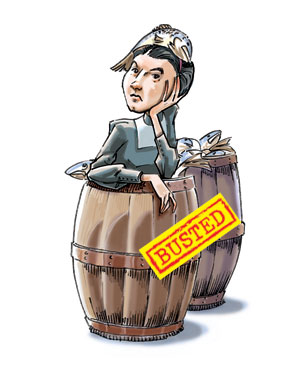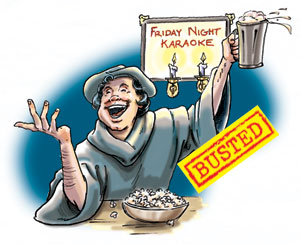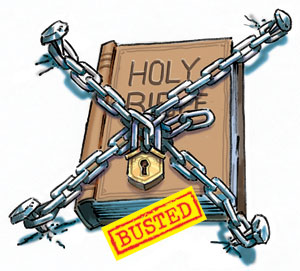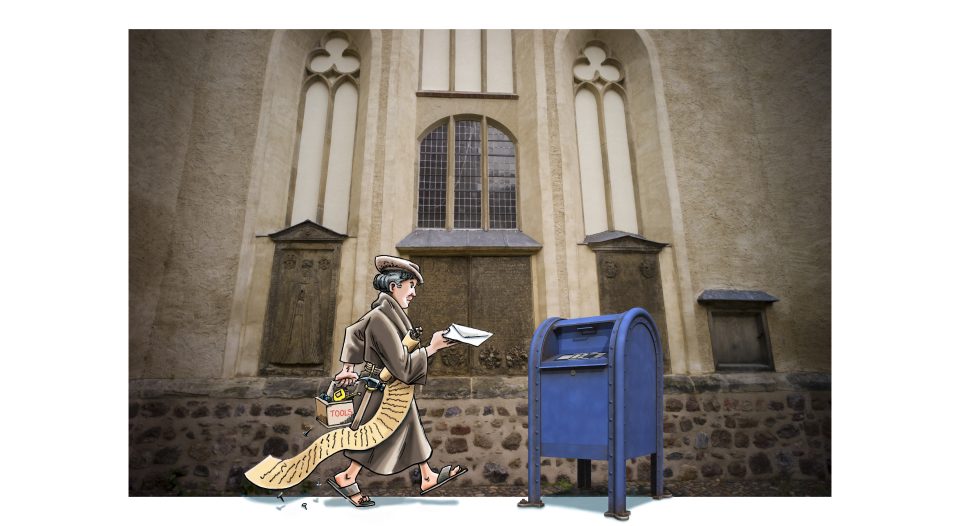Editor’s note: We celebrate Reformation Day on Oct. 31. In honor of this day, we are sharing this article by Timothy Wengert from 2015. Illustrations are by Michael D. Watson
On the popular cable show Mythbusters, the hosts unmask assumptions about our world — scenes from movies, familiar sayings or Internet sensations — and rigorously test their plausibility. When it comes to history, however, certain legends and inaccuracies can persist for generations without being challenged or corrected.
In the run-up to commemorating the 500th anniversary of the Reformation in 2017, here are 10 popular “myths” about Martin Luther that deserve busting.

On Oct. 31, 1517, Luther “posted” the 95 Theses in protest against the church.
Here modern historians have questioned two things. Since the 1960s some scholars have thought it highly unlikely that Luther ever nailed the 95 Theses to the door of the Castle Church in Wittenberg. They point to the fact that Luther never mentions it. Also, the posting is first mentioned in a sketch of Luther’s life written shortly after his death by a colleague, Phillip Melanchthon, who didn’t arrive in Wittenberg until 1518, well after the alleged act.
While some scholars (including this author) still argue that such a posting really did take place, all agree that the more important “posting,” which we know occurred that day, was in the mail as an enclosure to a letter addressed to Archbishop Albrecht of Mainz, head of the German church. The original, dated letter is in an archive in Stockholm, Sweden.
But the notion that the 95 Theses were, from their inception, a protest rests on the mistaken idea about the function of such “theses” in late-medieval university life. In those days, to receive any university degree students had to defend theses, usually composed by their professors and posted on the churches’ doors in advance of the oral defense.
In addition, as a professor of theology, Luther had the right to hold “quodlibital disputations” — debates on any subject whatsoever to clarify church teaching, which usually were presented in the form of theses. In the case of the 95 Theses, Luther was clearly thinking in those terms. His intent wasn’t protest but open debate about an issue over which there was great uncertainty: What were indulgences and how did they relate to a Christian’s sorrow over sin?
It was the reactions to Luther’s theses — the archbishop sent them to Rome because he suspected they contained heresy — that turned a sharp inquiry over church practice and teaching into protest and reform.

Katie Luther escaped her convent in (or next to) herring barrels.
An early chronicler of Katharina (von Bora) Luther’s escape with 11 other nuns noted that they were jammed into the fishmonger’s wagon “like herring barrels.” We might say they were packed in like sardines.
Later, sloppy readers took this to mean that Leonard Koppe, who regularly delivered fish to Katie’s monastery, snuck the women out on Holy Saturday 1523 in, or hidden among, fish barrels. Given the size of such wagons and the number of people involved, this is highly unlikely. Also, Luther, who was the first to write an account of this escape, never mentioned it.
But Luther and his fellow believers in Wittenberg knew just how dangerous this was. That same year in a neighboring Saxon duchy controlled by Luther’s sworn enemy, Duke George, a man was hanged for aiding another such escape. Koppe’s rescue was a capital offense.

Luther got the melody for “A Mighty Fortress” (or other hymns) from a barroom.
Here, perhaps, truth is stranger than fiction. The association with “bars” comes from a mistaken understanding of a term modern hymnologists use to describe the form of Luther’s hymnody: “bar form.”
Bar form simply means that the melody would begin with a theme repeated once before introducing a secondary theme and then ending with the last part of the original theme — rather like A-B, A-B, C, B. “A Mighty Fortress Is Our God” (Evangelical Lutheran Worship, 503-505) is just such a melody.
Now a great many of Luther’s tunes come from medieval modes and chants that he slightly revised to fit the rhymed German hymns he was producing. For example, he reworked an Advent hymn attributed to Ambrose of Milan, “Savior of the Nations, Come” (ELW, 263), setting the German translation to a medieval chant.
But some of Luther’s original hymn tunes were criticized for being too upbeat. He was one of the first to employ a major key for some of his hymns, including “A Mighty Fortress.” One scholar notes that Luther’s opponents complained about another such hymn, “Dear Christians, One and All, Rejoice” (ELW, 594) for being far too joyous a melody to be sung in church.
Such melodies that Luther, and quickly other Lutheran Christians, used sometimes had their origins in dance melodies and folk tunes — but probably not bars.
Luther thought himself a reformer of the church.
Here historians answer, “Yes and no!” We can trace changes in theology and practice in the churches of early modern central Europe to Luther. But he didn’t often — if ever — call himself a reformer. For one thing, the word “reformatio” was used for reconstituting practices and wasn’t a particularly radical word in his Latin vocabulary.
For another thing, Luther thought of himself more as a forerunner to the true reformation of the church that Jesus Christ would bring in, rather like the images of Elijah or John the Baptist at the time of Christ. Indeed, the famous Wittenberg painter Lucas Cranach often depicted Luther the preacher as John the Baptist, pointing to Christ, “the lamb of God who takes away the sin of the world.” That is what pastors today also are — “finger pointers” to Christ the savior of the world.
Luther hated peasants.
On a flight back from Germany, I was once seated next to a Philadelphia night watchman who was an amateur historian. When he heard what I did for a living, he got excited and said, “I’ve always wanted to ask two questions about Martin Luther. Why did he hate the peasants, and why did he hate the Jews?”
The second question was answered definitively by the ELCA Church Council in a 1994 statement titled “The Declaration of the ELCA to the Jewish Community” (search for this title at www.elca.org). Luther’s statements about the Jews were wrong, and we repudiate them.
When it comes to the peasants, however, the story is more complicated. When the Peasants’ War erupted in 1525, the peasants asked Luther to give his theological opinion of their demands found in “The Twelve Articles of the Swabian Peasantry.” He replied with an “Admonition” in which the nobles and peasants came in for almost equal condemnation.
After experiencing a small portion of the revolt firsthand, Luther then assumed (incorrectly) that the “Twelve Articles” was a ruse. So he wrote an appendix to his first tract, which was quickly reprinted separately, titled “Against the Murdering and Marauding Peasants” — that is, against these other lawless peasants who were destroying all good order. Even some of his supporters were shocked, leading him to write another tract in the summer of 1525 defending his harsh language.
When Friedrich Engels, Karl Marx’s early supporter, wrote a history of the Peasants’ War, he blamed Luther for being bourgeois and uncaring toward the lower classes. This was never the case. Luther’s grandfather had been a farmer, and he wrote many of his most important tracts to educate what he called the “simple” folk, that is, the illiterate. There weren’t nearly the enormous class distinctions in the 16th century that arose in German-speaking lands during the 18th and 19th centuries.
Luther wrote all those tracts during the Peasants’ War not to destroy German peasantry, but to prevent the chaos of revolution and protect those who were getting caught up in the fray against their will.

Luther invented the Christmas tree.
Of course, every age reinvents historical figures to serve their times. In this case, a famous 19th-century etching showing Luther and his family sitting around a Christmas tree rewrote history.
In Luther’s day the home Christmas tree had not yet been invented. Only in the 19th century do we find this practice spreading — first in Lutheran and Roman Catholic lands, and then in the U.S., from German and Scandinavian immigrants to others. Because of his well-known Christmas hymn “From Heaven Above” (ELW, 268), Luther was often associated with Christmas practices he had never heard of — the tree, the Advent wreath and, in this country, even “Away in the Manger” (ELW, 277).
Luther once said, “Even if I knew the world was going to end tomorrow, I would plant a tree today.”
This is one of those cases where even though he didn’t say it, the saying itself matches his theology — in two ways.
First, Luther very much assumed that the end of the world was near. Although he rejected speculation about the “day and hour” of Christ’s return, he was convinced that the time was near.
Second, rather than not caring for this world because it was ending, Luther thought the opposite and treated creation as a gift entrusted to us to care for — not to exploit or escape from.
In 1525, when he faced the Peasants’ War and attacks from many foes over human captivity to sin (against Erasmus of Rotterdam), over the efficacy of infant baptism (with so-called Anabaptists) and over the presence of Christ in the Lord’s Supper (with the Swiss reformer Ulrich Zwingli) — and therefore thought the world was ending — Luther didn’t plant a tree. But he did get married. One can hardly imagine a more positive statement about the goodness of creation and about how faith in Christ’s coming as savior frees us to serve our neighbor. Knowing the world was ending, Luther formed a family.
There are other statements attributed to Luther that he never uttered or wrote — and the Internet has increased their number. One favorite of mine: Luther said that every day when you wash your face you should remember your baptism. Despite it sounding “like Luther,” it doesn’t really match 16th-century hygiene, where the notion of washing your face wasn’t necessarily a daily chore.
Moreover, Luther made clear that the water of baptism wasn’t merely a “Bath-keeper’s baptism,” something those who rejected infant baptism often said. That is, the difference between baptismal water and regular water is the word and promise of God. Thus, washing your face is good for your face, but returning to your baptism daily is always a matter of trusting God’s promise of forgiveness, life and salvation offered there.
Luther, in fact, placed baptism at the center of the Christian life. We never lose God’s baptismal promises to us but may always return to them.
Perhaps what he says in the Large Catechism on baptism is even better than what we attribute to him:
“Baptism is not a work that we do but … a treasure that God gives us and faith grasps. … In baptism, therefore, every Christian has enough to study and practice all his or her life. … Thus, we must regard baptism and put it to use in such a way that we may draw strength and comfort from it when our sins or conscience oppress us, and say: ‘But I am baptized! And if I have been baptized, I have the promise that I shall be saved and have eternal life, both in soul and body ….’ ” (Book of Concord, edited by Robert Kolb and Timothy J. Wengert; Fortress, 2000).
Therefore baptism remains forever. Even though someone falls from it and sins, we always have access to our baptism so we may again subdue the old creature.
But we need not have the water poured over us again. Even if we were immersed in water a hundred times, it would nevertheless not be more than one baptism, and its effect and significance would continue and remain.
Luther had problems with constipation throughout his life.
In 1958 a famous psychiatrist, Erik Erikson, wrote a psychological biography of Luther in which constipation and toilet training played a large role, in line with the author’s Freudian convictions. In reality, despite all of the other physical ailments that fill Luther’s letters (kidney stones, ringing in the ears, palpitations, etc.) only for one brief time did he suffer from severe constipation.
In 1521, after being condemned as an outlaw at the Imperial Diet (parliament) meeting in Worms, Luther was whisked away into protective custody at the Wartburg Castle, an impregnable fortress belonging to the Elector of Saxony, Frederick the Wise. His diet changed dramatically from the rather rough fare of an Augustinian friar to the relatively rich food he encountered at the table of the castle’s warden, where he ate meals fit for a prince. In letters to his best friend, Georg Spalatin, he revealed his miseries, but never before or after.

Bibles were chained up in Luther’s day so no one could read them.
In Sélestat, an old town in Alsace, France, the 16th century library of a famous scholar, Beatus Rhenanus, has survived almost intact. There many large tomes — not just Bibles — have chains, not so they won’t be read but just the opposite: so someone couldn’t steal these costly books for private use. Chains were the 16th century’s equivalent of the modern “targets” that librarians put in books to prevent theft.
Before the Reformation, the Bible was everywhere — whole Bibles (even German translations made before Luther’s), excerpts in prayer books, stained-glass windows, statues and paintings inside and outside church buildings. The problem in Luther’s day was not so much the lack of biblical stories and passages. The problem was how people interpreted the Bible.
The same is true today. Many people think the Bible is something we must try to figure out, like an answer book or rulebook or even a star chart for predicting the future.
Luther discovered something quite different: God’s word is a word that works on us — putting to death the old, sinful creature through the law and raising up a new creature of faith through the gospel promises. When all one hears in church are rules and moral guidance for us to follow, then the Bible is chained up in a far worse way.
Luther was the first person to translate the Bible into the language of the people.
This is half true. The Latin translation (the Vulgate) already prepared in large measure by the fourth-century scholar Jerome was a perfectly good translation for its time because people in the Western parts of the Roman Empire spoke Latin. Translations into other languages were also produced in those days. In the 15th century several translations of Jerome’s Latin version were printed in German, among other languages.
Luther’s contribution was that he translated the Bible into German based upon the original languages of Greek and Hebrew. The first printed Greek New Testament appeared in 1516 and prompted Luther to begin learning Greek. When he began translating the New Testament while in protective custody at the Wartburg Castle in 1522, he already knew Greek well enough (helped by Melanchthon, his colleague and Greek professor) to base his translation upon the Greek text.
In the following years, the Hebrew text (helped by early translations of the Old Testament into Greek and Latin) served as the basis of Luther’s and his colleagues’ work.
We have examined 10 “legends” about Luther. There are doubtless many more, and our age will invent new ones. Once we peel away the myths and misunderstandings, however, what remains is a remarkable figure in the history of the church.
Luther rediscovered for the whole church that God gives salvation by grace alone — without any reciprocal gift on our part — received by faith in Christ alone, where that faith comes into being not by human decisions but by hearing God’s gracious word of forgiveness and reconciliation alone.






